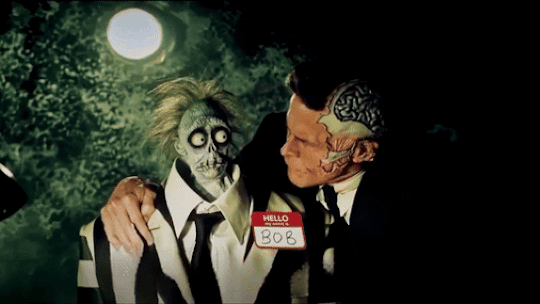#justice for bob
Explore tagged Tumblr posts
Text
Imagine confiding in Bob that you have a crush on Betelgeuse thinking he wouldn’t be able to tell him

#he probably wouldn’t anyway#justice for bob#beetlejuice beetlejuice#beetlejuice x reader#michael keaton#might write this
81 notes
·
View notes
Text

I finished my Beetlejuice AU fic that takes place during the plague. There’s a part where Beej is drafted into a feudal war and meets Bob and they become friends. Bob is the strong silent type but when he does speak his words have deep meaning. Beej often gives him advice on how to score with ladies, but Bob has a secret forbidden crush (hence why he puts up with so much shit).
There’s also a scene where Lydia writes a steamy letter for Betelgeuse that Bob offers to read out loud, but it’s a bit too hot for him.
https://archiveofourown.org/works/62163580/chapters/159013285
#beetlejuice#beetlejuice beetlejuice#ao3 fanfic#medieval au#bob#justice for Bob#beetlebabes#beetlejuice 2
27 notes
·
View notes
Text




He is so fine in this scene. 🥴
#ooh#interrogate me next#i'll cooperate#i'll tell you everything#also#justice for bob#he was done so dirty#poor guy#anyway#back to wolf#damn he looks good#so so good#i'm 🥴🥴🥴#🥵🥵🥵#wolf jackson#beetlejuice beetlejuice#willem dafoe
47 notes
·
View notes
Text
Here’s an injustice worth fighting for 💪🏼
Sign and share.
There must be some way to resurrect victims of Soul Suckers if the Soul Sucker is consumed by a Sandworm, right? There’s got to be something in the Handbook about that!

#beetlejuice#betelgeuse#tim burton#michael keaton#beetlejuice beetlejuice#justice for bob#soul sucker#sandworms#handbook for the recently deceased#bob the shrinker#beetlejuice 3#my artwork#beetlejuice fandom
18 notes
·
View notes
Text
Spoilers for Beetlejuice Beetlejuice:
They didn’t need to do my man Bob like that. I nearly started crying in the theater when he died. He’s just an innocent little guy
#justice for Bob#beetlejuice beetlejuice#beetlejuice#beetlejuice 2#bob beetlejuice#Beetlejuice Beetlejuice spoilers#shrinker bob#bob the shrinker
35 notes
·
View notes
Text

Made Bob at work for an event
22 notes
·
View notes
Text

Just came back from watching Beetlejuice Beetlejuice and I had to doodle Bob.
#beetlejuice beetlejuice#beetlejuice bob#justice for bob#Those shrunken heads man...that are sooo#Not me tempted to draw Bob in suggestive poses 😉😉#doodle
13 notes
·
View notes
Text

RIP Bob
3 notes
·
View notes
Text
Tim Burton in the audio commentary for Beetlejuice Beetlejuice 2024 A.D.: Bob's death was necessary. He deserved it. Me: Remind me to kick Tim Burton's ass if I ever run into him.
#Beetlejuice Beetlejuice#2024 A.D.#Tim Burton#audio commentary#director#Bob#Justice for Bob#what the hell Tim
5 notes
·
View notes
Text
bob: I'm generally a nice person, but I'm about to start throwing rocks at people.
42 notes
·
View notes
Text
Stranger Things did BOB friggin DIRTY
1 note
·
View note
Text

#justice for bob#beetlejuice#betelgeuse#beetlejuice beetlejuice#tim burton#bob the shrinker#afterlife call center#beetlejuice fan art
25 notes
·
View notes
Text
Rewatching the hobbit
Justice for Bob the Friendly Orc, he deserved better :(
#lotr#the hobbit#bob the friendly orc#bob#orc#THE ONLY SCREENTIME HE GOT#WAS GETTING HIT IN THE HEAD#WITH A BOWL#DAMN YOU MATILDA#HOW DARE YOU#justice#justice for bob
1 note
·
View note
Text
Beetlejuice Beetlejuice spoilers
Fly high Bob. I’ll lead the revolution to get you back
#justice for bob#shrinker bob#bob beetlejuice#beetlejuice 2#beetlejuice beetlejuice#beetlejuice#bob the shrinker
29 notes
·
View notes
Note
Your post on Bruce being the weakest human member of the league, makes me wonder what would happen if a new meta-human league member, after being criticised by Bruce for acting too rash on the field, turned around and essentially said something along the lines of 'What gives you the right to talk to me like that? At the end of the day, you're just some human.'
Cue a completely silent room and tension thick enough you could cut through it. I feel like before Bruce even had the chance to respond, multiple members of the league would step in first, especially Clark, if he's in the room when this interaction occurs.
I know it’s not super in character but I wish, in that moment, Bruce would simply step aside, tilt his head, and indicate that the meta should lead the mission themself if they feel so strongly. Kind of like when the Chef in the Menu let Tyler cook in the kitchen just to watch him fail (theoretically this would be a mission that doesn’t affect civilians etc).
Clark would be furious and so would everyone else. But maybe they’d still defer to Bruce and let the hotshot run the mission into the ground. Sometimes to teach a lesson, failure needs to be at full intensity.
Bruce would step in at the end, a la Speirs in Band of Brothers, reach a hand down to the frazzled meta, and ask him if he wanted him to step in. Calm voice, confident posture, no obvious grudge or resentment. Just Batman offering to lead the mission after all.
#actually the speirs scene in BOB where he takes over haunts me#one day I will write it into a fic#batman#bruce wayne#dc#asks#anon#clark kent#superman#justice league#jl#rambling#treadmill thoughts#except today I’m actually on an indoor track#and I almost ran into someone while typing this lmao
416 notes
·
View notes
Text
@hangmanapologist ROBYN I totally agree I love Bob and Bob fics!!! Single handedly trying to bump him up into top billing
This is for science people
18 notes
·
View notes